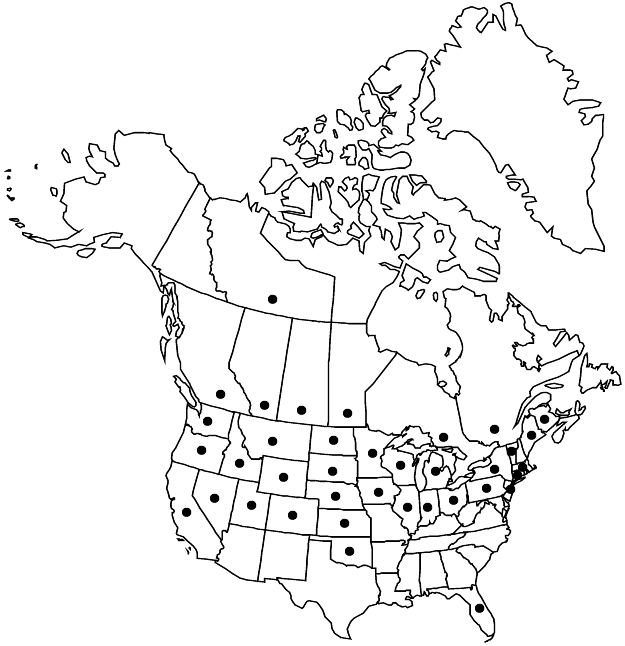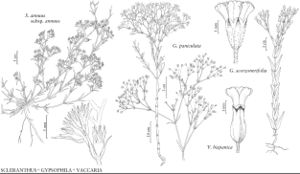Gypsophila paniculata
Sp. Pl. 1: 407. 1753.
Plants perennial. Stems erect or ± sprawling, diffusely much-branched at or near crown, 4–10 dm, glabrous or occasionally glandular-puberulent or scabrous near base. Leaves cauline, bases not clasping; blade linear-lanceolate to oblong-lanceolate, larger leaves 2–9 cm × 2–10 mm, apex acute to acuminate, glaucous. Pedicels 1–20 mm, glabrous. Flowers: calyx 1–3 mm, lobes glabrous, apex rounded to obtuse; petals white or rarely light purplish pink, 1–4 mm. Capsules globose. Seed coats coarsely tuberculate. 2n = 34, 68 (both Europe).
Phenology: Flowering summer–fall.
Habitat: Fields, roadsides, beaches, other open, sandy, disturbed sites
Elevation: 0-2600 m
Distribution

Introduced; Alta., B.C., Man., N.B., N.W.T., Ont., Que., Sask., Calif., Colo., Conn., Fla., Idaho, Ill., Ind., Iowa, Kans., Maine, Mass., Mich., Minn., Mont., Nebr., Nev., N.J., N.Y., N.Dak., Ohio, Okla., Oreg., Pa., S.Dak., Utah, Vt., Wash., Wis., Wyo., Eurasia.
Discussion
Gypsophila paniculata, which is widely cultivated as a garden ornamental and florists’ crop, occurs rather sporadically in eastern North America, mostly in waste places, although it occasionally forms sizeable local populations in soils that are not strongly acidic. In parts of central and western North America, in contrast, it has become an abundant and widespread weed in hayfields and pastures, often being dispersed as a tumbleweed. Its roots may extend four meters into the soil. It has been designated a noxious weed in California, Washington, and Manitoba. Also, there is concern that the spread of G. paniculata in the dune-swale complexes around the upper Great Lakes presents a threat to some of the rare species that are largely restricted to these habitats (K. D. Herman 1996).
Botanical varieties of Gypsophila paniculata have been based on the distribution of pubescence on stems and leaves, but are doubtfully worthy of taxonomic recognition. Both glabrous-stemmed plants and plants with proximally glandular-puberulent stems are naturalized in North America. Cultivars have been selected for compact habit, supernumerary petals, petals to ca. 8 mm, and/or pink petals. Occasional naturalized plants have purple-tinged pedicels and calyces. A form with supernumerary petals has spread from cultivation in northern Michigan. The ploidy level(s) of populations in the flora area have not been investigated.
